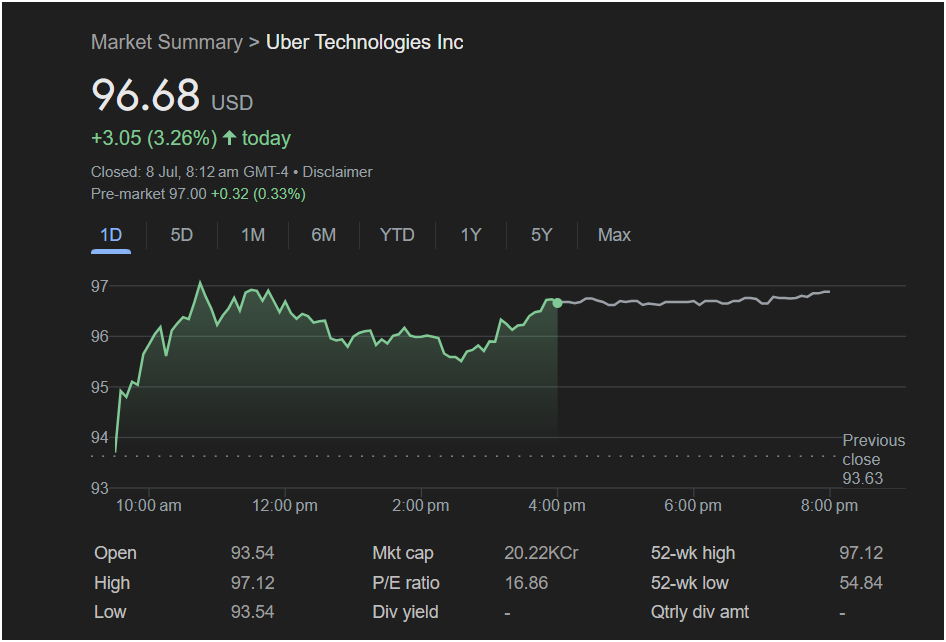Uber Surges 3.26%, Hits Record High of $97.12 — A Definitive Breakout and a New Era of Profitability

SAN FRANCISCO, CA – July 8, 2025 — Uber Technologies Inc. (NYSE: UBER) delivered a powerful performance on Monday, closing the day at $96.68, a gain of $3.05 or 3.26%, and marking a new 52-week high. With investor confidence swelling, the ride-hailing and delivery giant is now seen not just as a disruptive force — but as a fully matured, profitable tech powerhouse.
The stock’s impressive rally is more than just a number. It marks a historic shift in Uber’s narrative — from a high-growth, cash-burning upstart to a disciplined platform company with sustainable earnings and strategic leverage. This multi-part deep dive explores Uber’s breakout day, its financial profile, and the strategic pillars behind its rise.
Part I: Anatomy of a Breakout — The Technical Picture
Opened at the Low — A Classic Bullish Signal
Uber kicked off the session at $93.54, which also marked the intraday low. Such a pattern — where the opening price is the lowest point — is a strong indicator of relentless demand, often driven by institutional accumulation or bullish sentiment triggered by news or analyst upgrades.
 Rapid Ascension and Blue-Sky Breakout
Rapid Ascension and Blue-Sky Breakout
The stock surged past resistance levels at $94, $95, and $96 early in the session, culminating at 11:00 AM with a new 52-week high of $97.12. This breakout into “blue-sky territory” — with no prior price ceiling — is technically significant and tends to attract momentum traders and funds.
Healthy Consolidation Confirms Strength
Following the morning rally, Uber held steady in a narrow range between $95.50 and $97.00 — a bullish sign that the gains were not speculative or temporary. Instead of selling off, the stock digested its climb, indicating that institutional buyers remained committed.
Strong Close, Stronger Signal
Uber ended the day at $96.68, just below the intraday high and near an all-time high. In after-hours and pre-market trading, the stock continued its upward trajectory, trading at $97.00, a 0.33% increase. This continuation signals that bullish momentum is still in play.
Part II: The Financial Case — From Growth Stock to GARP Darling
Market Capitalization: Tech Giant Status Confirmed
Uber’s market cap is listed at ₹20.22K Cr, equivalent to roughly $243 billion at current exchange rates. While U.S.-based sources estimate closer to $200 billion, the message is clear: Uber is now a mega-cap global tech player.
P/E Ratio of 16.86 — A Milestone for Uber
For the first time, Uber sports a Price-to-Earnings (P/E) ratio of 16.86. This is not just a number — it marks a turning point. Uber now generates real earnings, and more importantly, it trades at a valuation traditionally associated with stable, mature companies.
This places Uber squarely in the GARP (Growth at a Reasonable Price) category — a rare combination of strong future growth and modest valuation.
No Dividend? Smart Capital Allocation
Uber does not pay a dividend, and that’s perfectly aligned with its strategy. Instead, the company is reinvesting profits into growth — particularly in emerging areas like Freight, Advertising, and AI logistics — to build long-term shareholder value.
52-Week Range: A 77% Rise
From a 52-week low of $54.84 to the new high of $97.12, Uber has delivered a 77% gain to shareholders within a year. This kind of outperformance underlines the market’s conviction in Uber’s evolution from a risky bet to a robust, profitable enterprise.
Part III: Strategic Flywheel — What’s Fueling the Growth?
Mobility + Delivery = A Synergistic Ecosystem
Uber’s ecosystem benefits from its dual core:
- Drivers serve both Mobility and Delivery markets, optimizing driver utilization.
- Users often use both services, allowing Uber to lower acquisition costs via cross-selling.
- Data from both segments enables hyper-optimized routing, demand prediction, and city planning.
Levers Driving Profitability
- End of Subsidy Wars: Uber has moved past loss-leader pricing. Competitors now prioritize profit over market share.
- Operational Efficiency: Tech-powered automation has drastically cut costs across routing, batching, and fulfillment.
- High-Margin Ventures: New businesses like advertising (within the Uber Eats app) are providing lucrative revenue streams without proportional costs.
Part IV: Forward Outlook — What’s Next for Uber?
The breakout to $97.12 is a culmination of years of strategic recalibration. Uber has silenced skeptics who once doubted its ability to achieve profitability at scale. With a reasonable valuation, disciplined capital allocation, and multiple high-margin verticals ramping up, Uber appears poised for further upside.
Investors should watch the following:
- Continued margin expansion in Mobility and Delivery.
- Growth of Ads and Freight businesses.
- Uber’s role in AI-powered logistics optimization and autonomous fleet development.
Uber’s 3.26% surge and breakout to a new high is more than a short-term win — it’s a resounding vote of confidence in its transformation. What began as a volatile, unprofitable disruptor is now a disciplined, data-driven technology platform with global reach and sustainable earnings.
With strong fundamentals, a GARP-worthy valuation, and a growing strategic moat, Uber is no longer just a ride-hailing app — it’s a full-fledged tech powerhouse rewriting the playbook for what Silicon Valley scale-ups can become.
Would you like this article formatted into a downloadable PDF or published-ready blog post?





